Bubbling Up
Méthode Champenoise has a Sparkling Future in Oregon
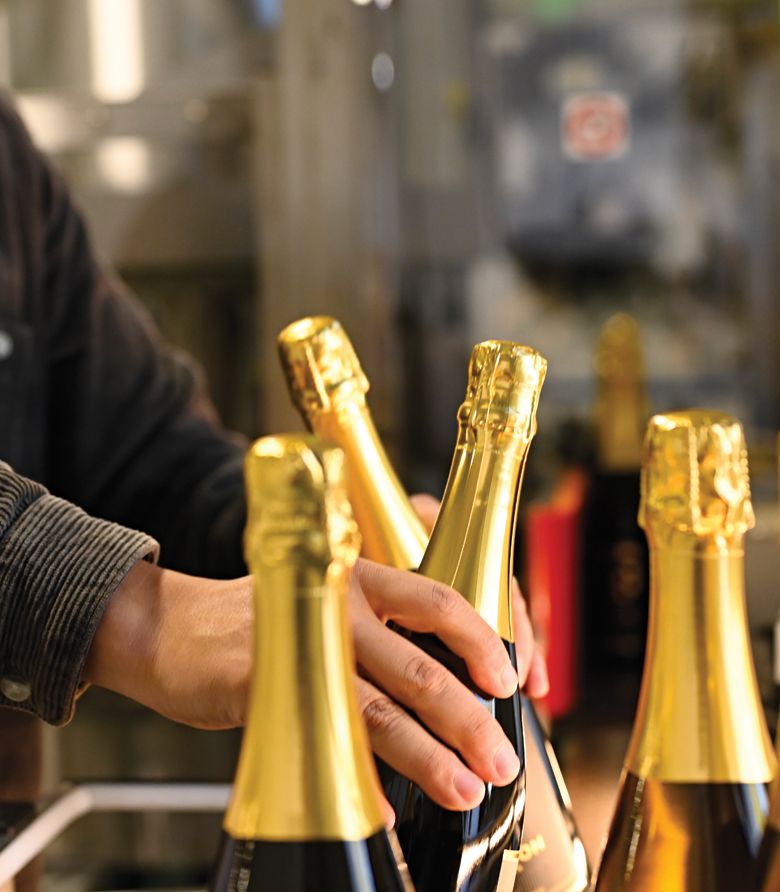
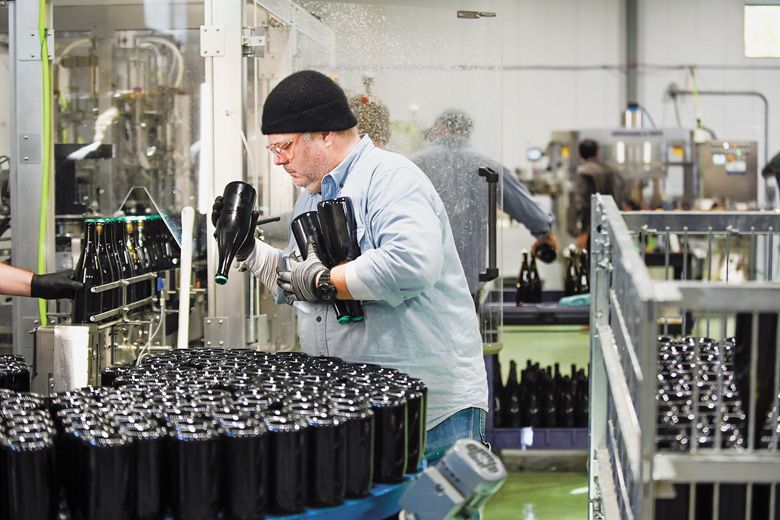
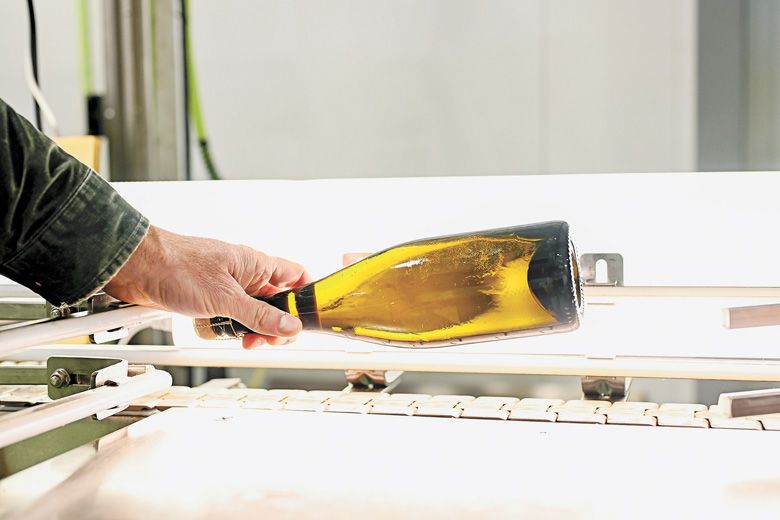
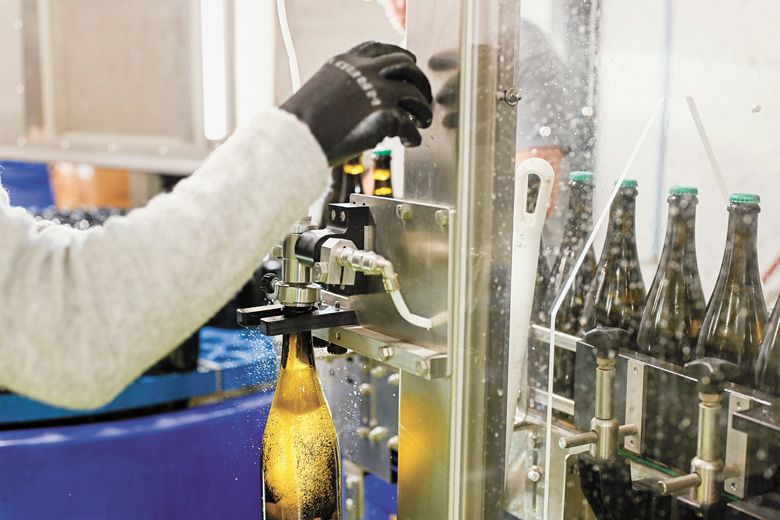
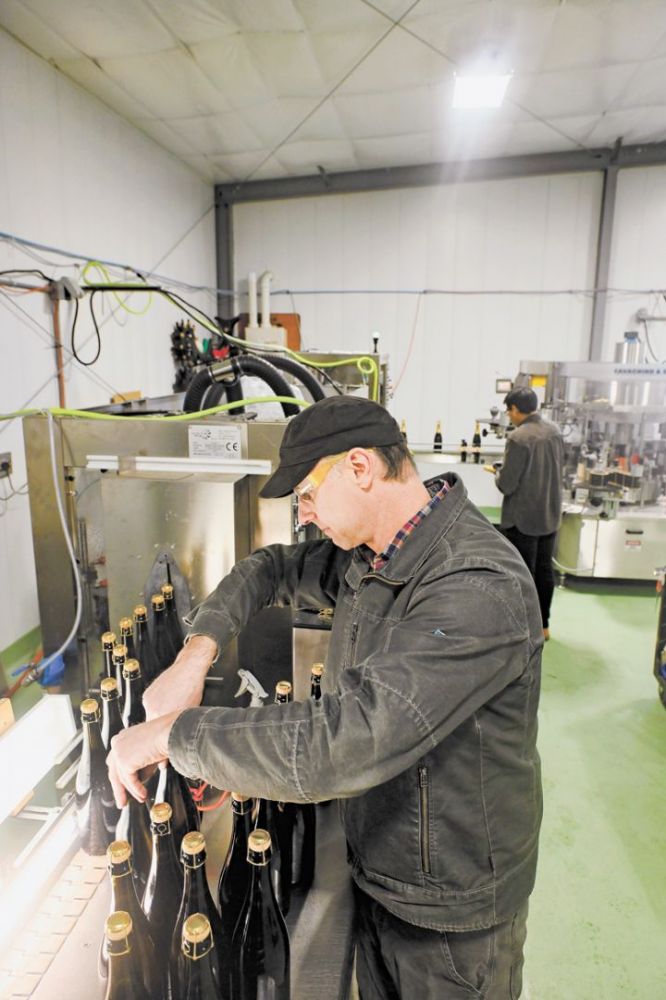
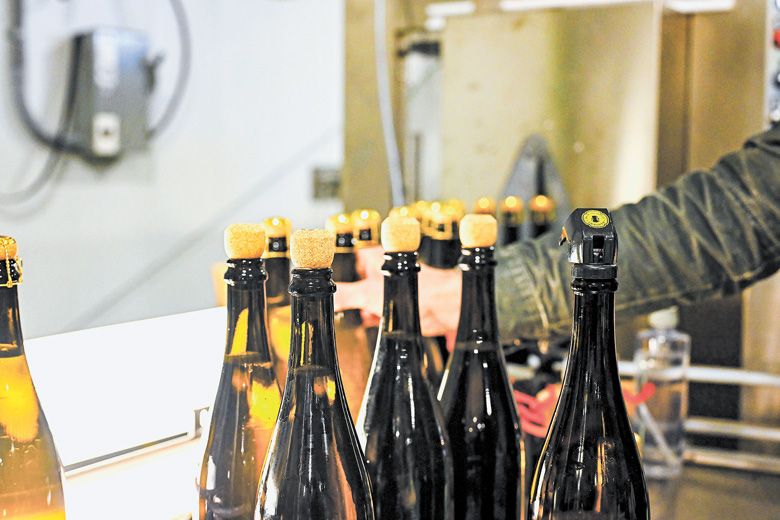

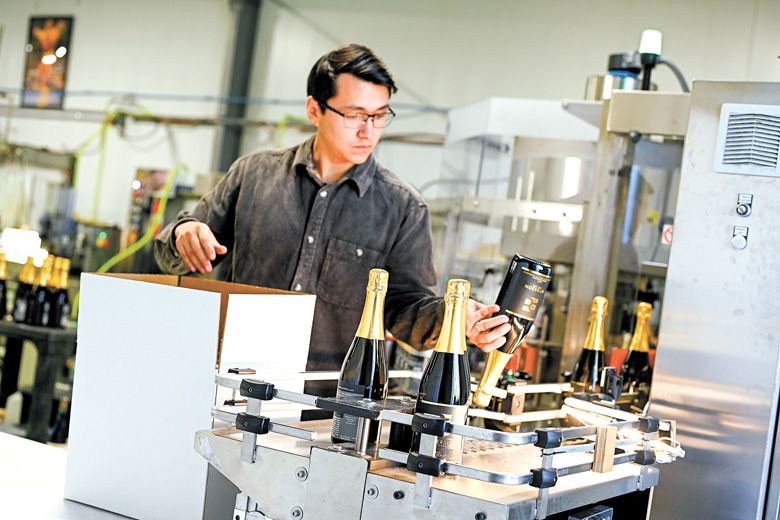
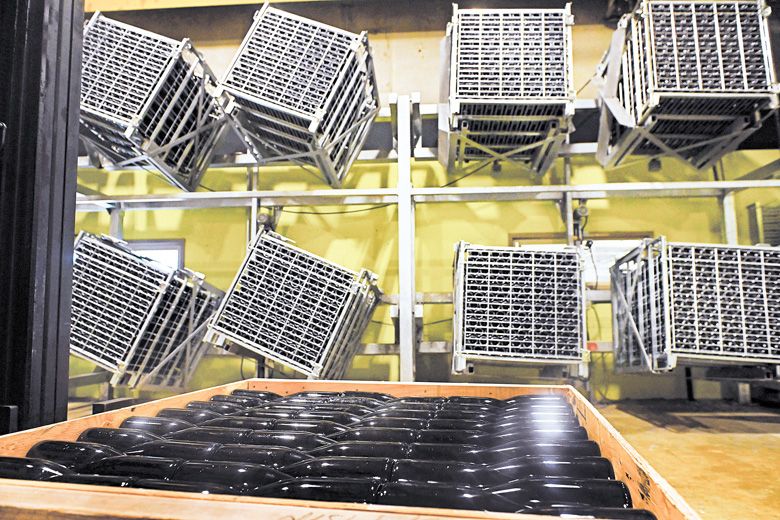
Story by Annelise Kelly | Photos by by Carolyn Wells-Kramer
First, you grasp the cork and twist the hefty bottle, producing a soft sigh that culminates in a gentle pop. A subtle symphony caresses your ear as you pour the wine, transforming to a delicate whispered effervescence as it settles in the glass. Holding it to the light, you admire a constellation of pin-point shooting stars traveling through a radiant golden backdrop before surfacing. A delicate bouquet arises of flowers, fruit and romance. Taste the elixir: bubbles dance on your tongue, delivering evocative flavors both bright and ethereal. Brilliant blond and crystal-clear, each flute of Champagne is a complex celebration of the senses.
No wonder sparkling wine is the quintessential celebratory choice.
“I've come to realize that, wow, everyone is grinning when they've got a glass of bubbles in their hands,” says Andrew Davis, the founder and owner of The Radiant Sparkling Wine Company supplying equipment and expertise to small-production sparkling wine producers. “Smiles are contagious. You never see anyone with a glass of bubbles in their hand looking all too serious.”
Yet bubbly’s appeal isn’t strictly limited to the sensory experience. “It's about conviviality and sharing,” says Jean-Michel Jussiaume, who makes sparkling wine under his own label, Maison Jussiaume, and also serves as winemaker at Del Rio Vineyard Estate. “When you think about sparkling wine, you think about celebration, you think about people. I really like this part, in fact, it is the most important part of wine, the sharing.”
Why does sparkling wine hold this charming place in our hearts? Perhaps it’s the magic of the bubbles. As children, we feel captivated by the fleeting magic of soap bubbles. As adults, the prospect of consuming bubbles enchants us. It’s unusual: still wine is common, so sparkling wine automatically becomes special. It’s ephemeral: the transient bubbles inevitably fade. As the favored drink of royalty, sparkling wine cultivated a reputation both refined and exclusive.
You also may have noticed that it costs more. The price isn’t simply due to its relative scarcity. Requiring more time and labor to craft, the delicate nature results in a far smaller margin for error. Sparkling wine must be crafted with great care, precision and attention to detail.
As we approach the holidays, here’s a primer on traditionally-crafted sparkling wine, also known as Méthode Traditionnelle and Méthode Champenoise. “I think that there's a big knowledge gap between the cluster on the vine and the ‘pop’ when the cork is removed,” says Davis. He observes that an incremental understanding of how it’s made will “feed the curiosity that I know a lot of drinkers have. The more they know, the more they'll enjoy it.”
A Rose by Any Other Name Would Smell as Sweet
Let’s discuss nomenclature. The most celebrated source of sparkling wine belongs to the region known as Champagne in northeast France, about a hundred miles east of Paris. While the region comprises five separate viticultural districts, the name “Champagne” is strictly controlled by the country’s Appellation d'Origine Controlee, or AOC, program. This safeguards legal protection of the name while also applying strict regulations to the method of production. Spain has similar laws in place to protect Cava, also made using the Méthode Traditionnelle or Méthode Champenoise style.
In America, sparkling wine includes any grape wine that is effervescent with carbon dioxide resulting solely from fermentation within a closed container, either tank or bottle. The labels Méthode Traditionnelle and Méthode Champenoise imply that the secondary fermentation occurs in the bottle, in the traditional manner perfected in Champagne, “but I am unaware of any legal context in the U.S. that codifies that terminology,” says Davis. Sparkling wine can also be fermented in stainless steel tanks for both first and second fermentations, known as the Charmat Method.
Prosecco is an example of sparkling wine made using the Charmat Method, and can be of excellent quality. Davis points out that this method requires a greater investment in equipment and time. For example, it involves large, pressurized tanks that will hold wine under pressure for as long as nine months, so “it lends itself to greater scale than what we're producing in Oregon.”
A third way to make wine bubbly is forced carbonation, adds carbon dioxide into a still beverage. “If something is force-carbonated, it needs to be labeled ‘carbonated wine beverage,’” according to Davis. “And that does not sound sexy. If they are force-carbonating, they cannot say ‘sparkling’ wine. But I know it happens all the time; I see it on the shelf. The problem is when people apply for their labels with the government, there's no question asking ‘how did you get your bubbles?’ The Alcohol and Tobacco Tax and Trade Bureau, or TTB, assume if you're putting sparkling wine on the label, you're using the right verbiage. But they don't check, so confusion in the marketplace is common.”
Drinking the Stars
According to legend, the first Champagne was brewed by a French Benedictine monk, Dom Pierre Pérignon, who allegedly exclaimed “come quickly, I am drinking the stars” when he first sampled it.
What are the characteristics of an ideal Méthode Champenoise? As with any aesthetic, it exists in the eye, nose and palate of the beholder.
“You are looking for grace, elegance and tiny bubbles,” says Davis. “There should be a bright, clean character to the wine, with layers of complexity and depth. Extended aging in the bottle on the yeast creates notes often described as brioche, baguette, toast or bread starter. These are the complex aromas and flavors that developed with time. You should expect them in a Méthode Traditionnelle or Méthode Champenoise sparkling wine.”
He explains how notes of bread products resulted from “the years the wine spends on the yeast that fermented it. As the spent yeast accumulates at the bottom of the bottle, proteins are released as it breaks down. It creates creaminess— like you find in bread dough— further contributing to the palate. That is one of the beguiling, compelling and desired flavors within a traditional sparkling wine. Even though you've got chemistry in the wine similar to lemon juice, that creaminess is characteristic of topnotch bubbles, whether from Oregon, Northern Italy, Champagne or California, dare I say.”
“I want to make bright sparkling wine that’s fresh, friendly, even stimulating,” states Jussiaume. “My style reflects my origins: I'm originally from France, my family makes a dry, white wine called Muscadet in the Loire Valley. Once I arrived in Southern Oregon, I began brainstorming on what kind of wine would best exhibit the same spirit as our Muscadet, a wine that is bright and lively above all else. To me, the obvious answer was sparkling wine; it was really the best choice to represent the essence of my family’s wine because it’s all about conviviality and sharing. When pondering sparkling wine, you are reminded of celebrations and people. Sparkling wine embodies enjoyment, sharing — I think it fits me.”
Jussiaume notes, “there is an aromatic evolution in ripeness in sparkling wine. It starts with mostly unripe, and vegetal notes presenting, and then the aromatics move slowly toward green, unripe apple, then further to immature lime and lemon, before evolving into ripe lime, lemon and ripe apple, before moving finally to orchard fruits like peach and pear. So, with the objective of making a bright, friendly and stimulating sparkling wine, it means I like to be harvesting when the aromatics are between 'ripe lemon' and a 'hint of apple’.”
Making Sparkling Wine, Step by Step
Davis shared a precise progression of the entire process for making Méthode Traditionnelle or Méthode Champenoise. “Taking the white juice to its base wine form is as simple as any other winemaking process,” he says.
It starts with harvesting primarily Pinot Noir, Chardonnay and Pinot Meunier grapes, exactly as in Champagne, France. The objective is to pick at fairly low sugar levels, around 18-20 brix, rather than the 22 to 25 range typical for a still wine.
The grapes must be pressed gently. It’s critical to press them more lightly than a still wine because “you don't want too much phenolic content,” advises Jussiaume. “The aim is to slightly squeeze the berries in order to free all the juice from the pulp while trying not to damage the skins because even a little bit of this phenolic can easily impart a harsh bitterness that becomes especially apparent with CO2 from the bubbles. You want a very pure base wine, something extremely elegant, where every accentuation has to be controlled. It's all about delicacy.”
Davis agrees: “with sparkling, you're trying to extract the sugar and acid from the core of the berry and avoid color, phenolics or tannins from the skin. You're looking for grace and elegance rather than texture.” In addition, those phenolics chemically inhibit the formation of fine bubbles.
The next step is primary fermentation, just as a still wine. “You add yeast and let it ferment,” says Davis. “Whether you do that in a tank or a barrel is a style choice; both are equally valid for sparkling wine production. Malolactic fermentation represents another stylistic choice utilized by some winemakers. With sparkling wine, you've got a much broader range of techniques you can use for base wine production than you do sometimes with other wines. You can put in the tank and/or barrels, coax it through malolactic fermentation (or not), give it a warm or cold ferment– all techniques that impart different characteristics into the wine, and equally valid.”
Once the base wine completes fermentation, the winemaker “starts to blend a cuvée.” It can be a brut cuvée, with both red grapes and white grapes, all-white grapes, known as Blanc de blanc, all-dark grapes, referred to as Blanc de noir, or a rosé.
After blending, tartrate stabilization prevents the formation of potassium or calcium tartrate crystals. This is achieved by cold stabilization or adding specific ingredients. Next, the base wine must be clarified, usually by filtration, to ensure stability.
Tirage follows. This is the addition of “a measured amount of sugar and yeast. The amount of sugar you add is relative to how much pressure you want in the final bottle,” says Davis. The yeast creates alcohol and CO2, critical for creating bubbles during the second fermentation. Some also include an adjuvant, or riddling, aid to help compact the yeast for easier removal.
Each bottle is then closed with a bidule stopper and a crown cap closure. This seal not only limits the ingress of oxygen during the secondary fermentation, but also makes it easier to collect the spent yeast during the riddling process, ensuring more successful disgorgement.
For the secondary fermentation, the bottles are stored on their sides to age. “At this point, you wait. You wait one, two, three, five, ten years, until the winemaker feels this wine needs to be in bottle before disgorging,” says Davis. “Unlike other wines, the aging is done by the winery and not by the consumer.”
With aging is complete, the bottles must be riddled. The bottles are gradually tipped, shifted and turned to collect the spent yeast in the neck. It can be done by hand or with a gyropalette.
Disgorging is the process of extracting the spent yeast. The bottles are cooled with approximately the top inch of the neck frozen, enabling the winemaker to remove the crown cap and bidule, along with the yeast plug, all with minimal loss of wine or CO2, and “you're left with beautiful, clear wine,” says Davis.
“The last step before bottling is called dosage; a mixture of wine and sugar,” says Davis. “That's when the winemaker determines the balance that they want.”
Then each bottle is sealed with a cork and wirehood (also known as a cage). An optional foil capsule may be placed over them. Finally, “it's washed, it's labeled and packaged.”
This multi-step, manual process is one reason Méthode Traditionnelle or Méthode Champenoise wines are more expensive. Each bottle must be handled about a dozen times, in contrast to still wines, often held just twice.
The Future of Oregon Méthode Champenoise
Davis estimates Oregon’s annual production of Méthode Champenoise is fewer than 100,000 cases— he anticipates a bright future for Oregon’s sparkling wine industry.
“I think that each of the old-world regions seems to have a new world analog.” He compares Bordeaux to Napa and Sonoma, each crafting “top-notch expressions of Cabernet, Merlot and Cabernet Franc.” Burgundy’s closest comparison is Oregon, with both regions “using Pinot Noir grapes at an exceptionally high level.” While most regions dabble in sparkling wines, “no one has been able to rise to icon status. And I believe Oregon is suited for that. With a bit more time and production, we can be that new world analog to Champagne. We've already proven that Chardonnay and Pinot grow spectacularly here.”
Oregon’s advantage originates with our climate. Maritime conditions coupled with long, slow growing seasons allow winemakers to harvest grapes at lower sugar levels with plenty of time for flavor development, along with the acidity required for good sparkling wine.
Jussiaume agrees sparkling wine has enormous potential in Oregon. “Me personally? I believe in it and want to make more. Everyone seems to offer sparkling wine now. There is a big trend and I think with time, things will settle and we will discover our style. Because I’m four hours south of the Willamette Valley, mine will certainly be different. These days, I'm investing a lot of my time and believe there is a bright future here for sparkling wine.”







